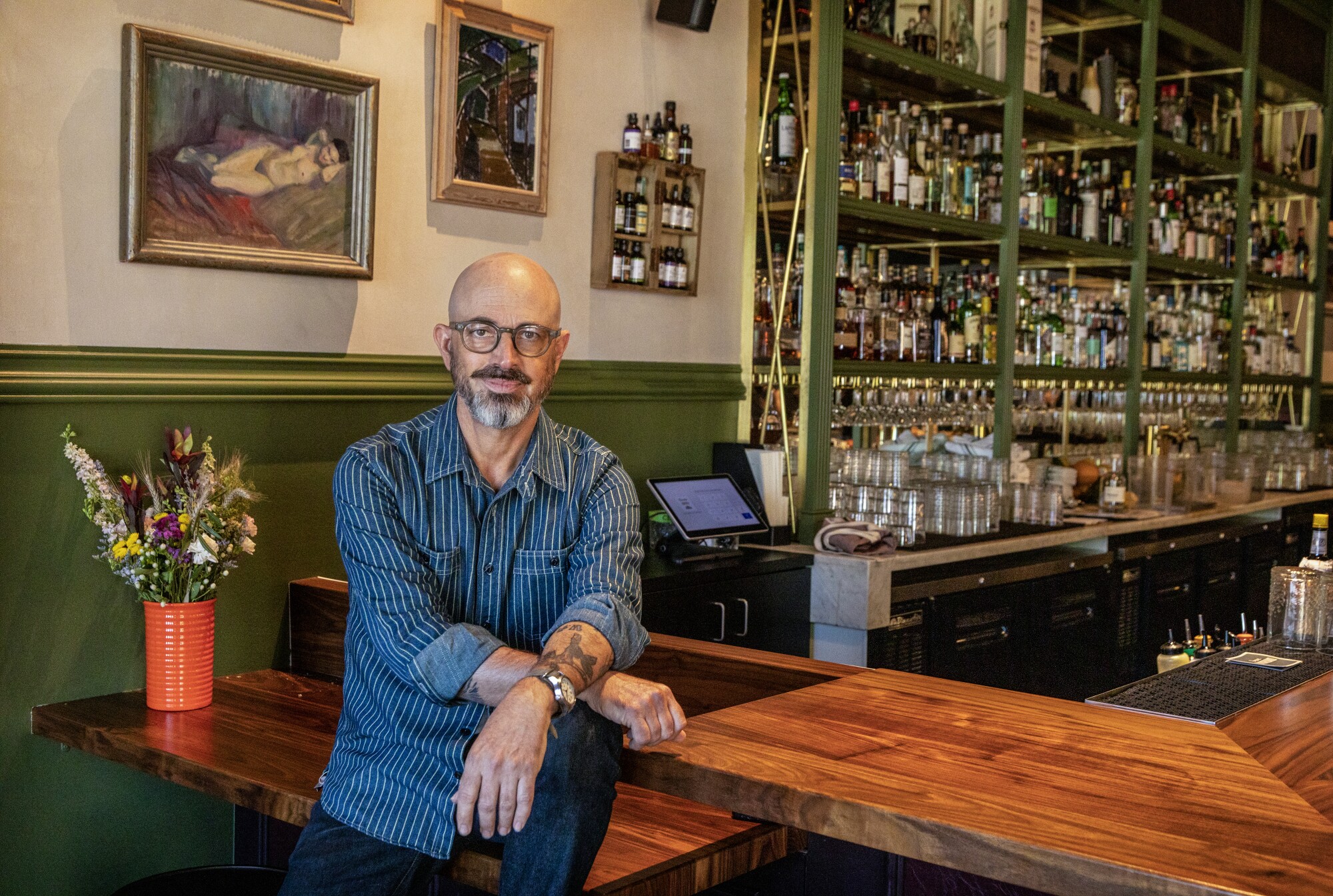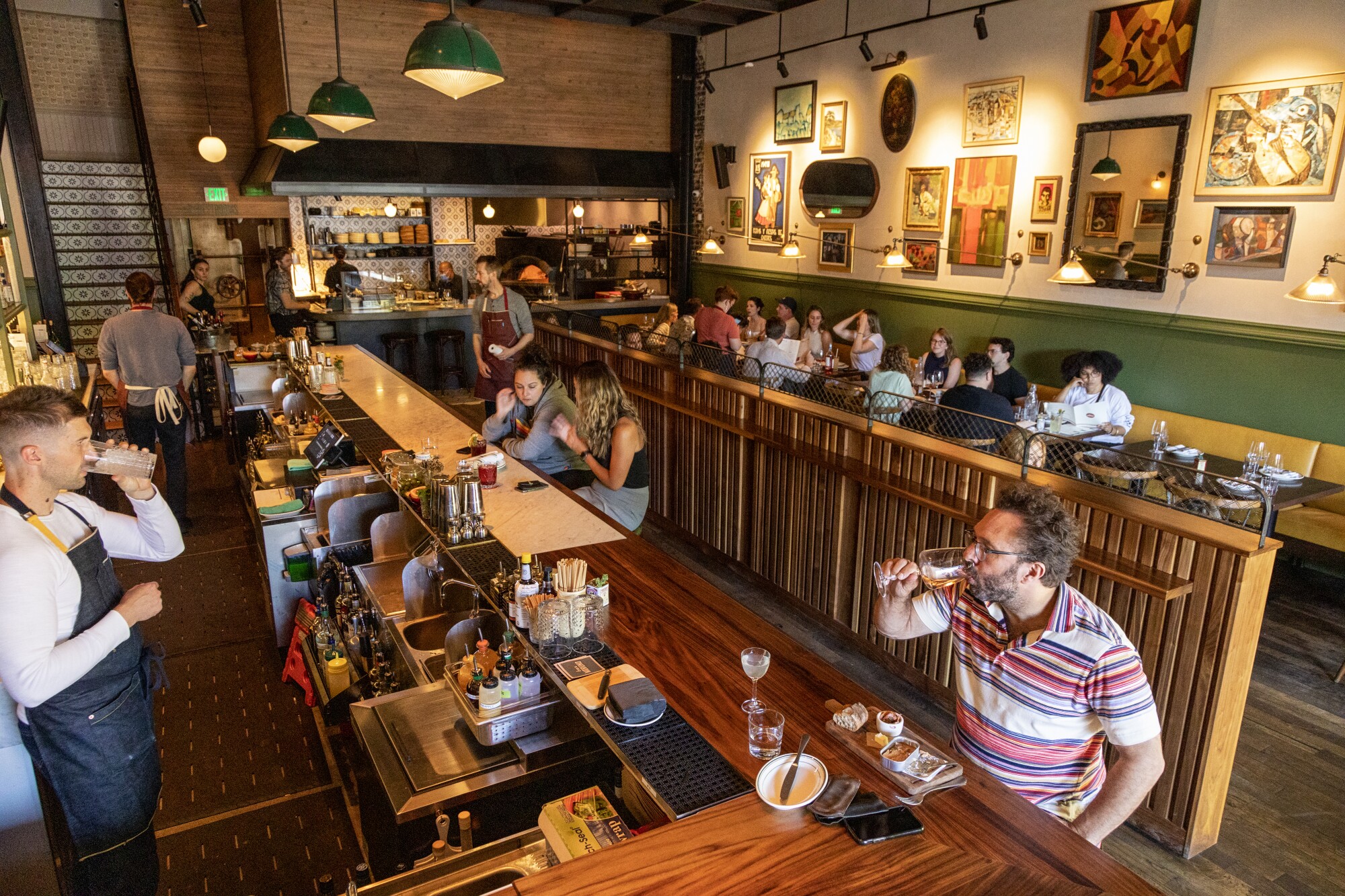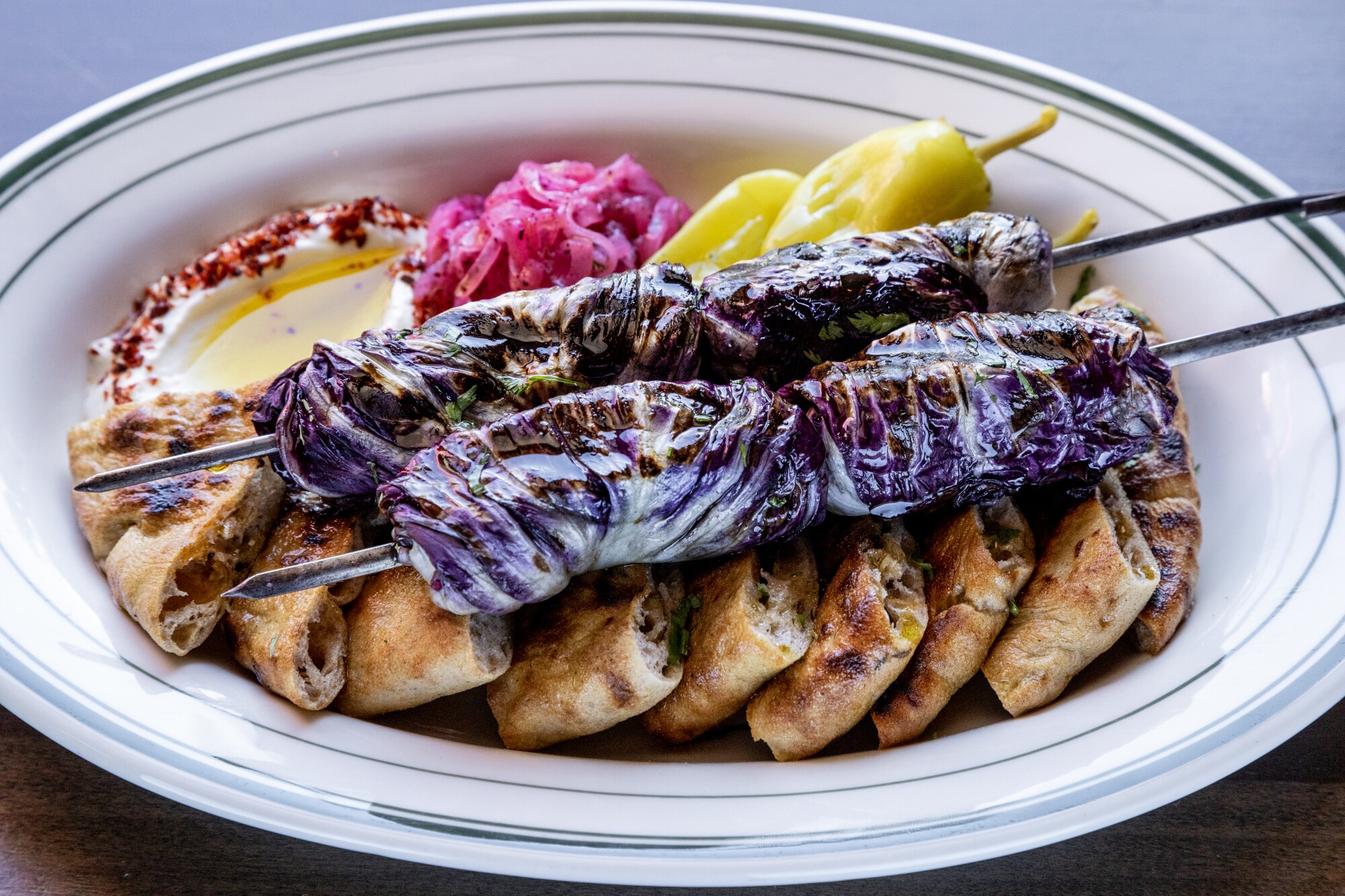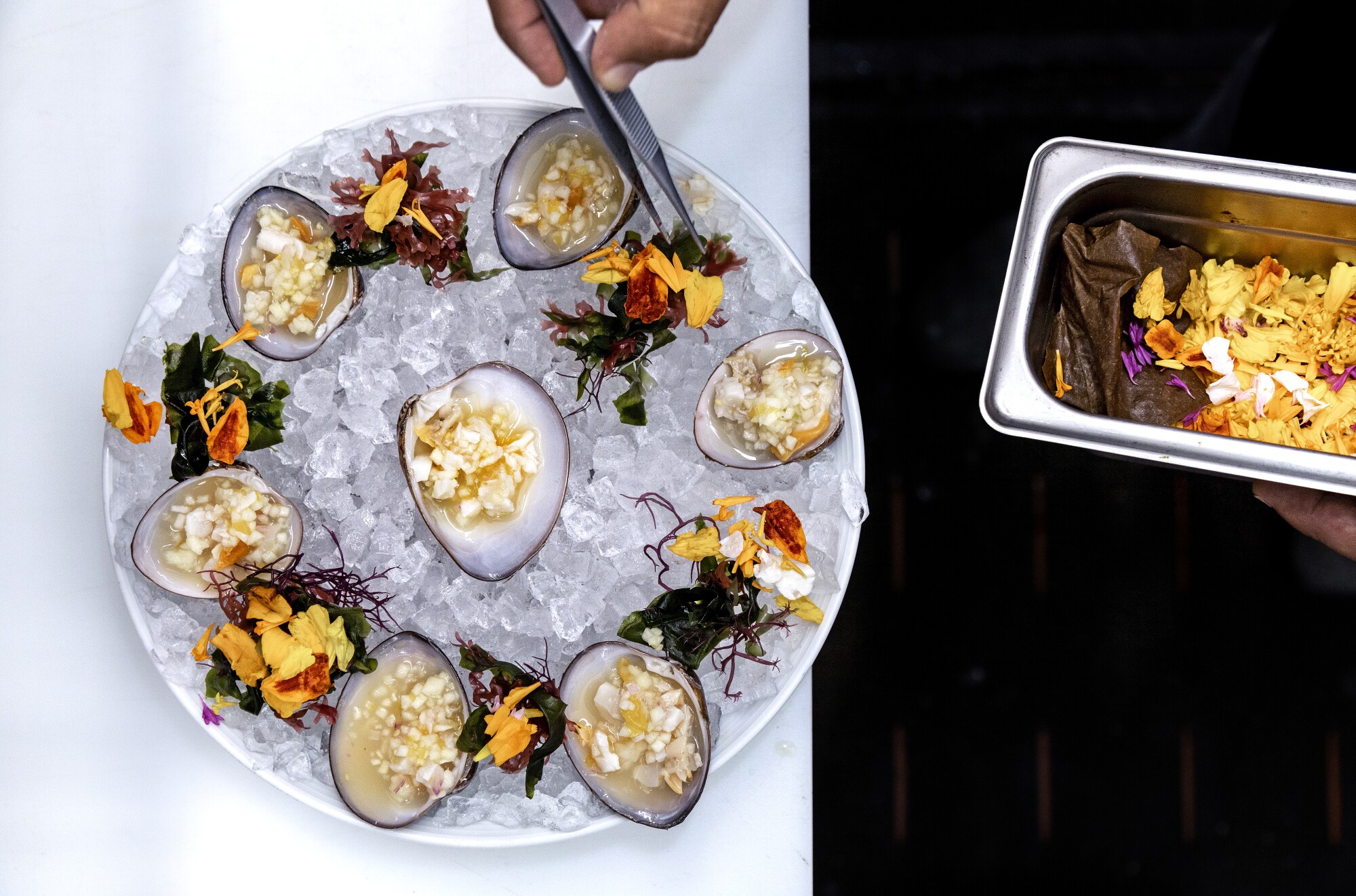I’ll never forget my first conversation with David Rosoff, one of the great wine savants of Los Angeles who has been helping to shape our tastes for decades. Our exchange was a few years back when he was general manager at Hippo in Highland Park. He had plenty of responsibilities but, as I’d come to learn, he’d happily materialize tableside to discuss his favorite subject.
I was on an orange wine jag at the time (many of us were) and asked for a recommendation. Rosoff responded with a screed — a cheerful one. Though he’d centered Hippo’s list on wineries dedicated to sustainable practices, he also railed about the general vagueness of the term “natural wine” and how vinegary so many that fall under the equally broad “skin contact” label could be. Then he steered me to a pumpkin-colored, apricot-scented model of balance from Greece. More than the food, I most remember his high-wattage grin and his hands gesticulating his impassioned opinions.

Managing partner David Rosoff at Bar Moruno.
(Ricardo DeAratanha / Los Angeles Times)
He’s had lots of practice delighting customers, working over the last 30 years at landmarks like Michael’s in Santa Monica, Campanile and most notably Osteria Mozza and its next-door pizzeria. His corps of plain-speaking sommeliers there, aided by an encyclopedic selection, detangled the mysteries of regional Italian wines with the ease of pulling slipknots.
Last year, Rosoff started his own hospitality group called Intent to Dine. The company’s first undertaking is a three-in-one project that began launching in the spring: two restaurants and a small market located side by side on the curve of Sunset Boulevard in Silver Lake next to Sunset Triangle Plaza.

Causita restaurant, Rápido and Bar Moruno, all under the same leadership, sitting in a row on Sunset Boulevard in Silver Lake.
(Ricardo DeAratanha / Los Angeles Times)
Rápido, the small storefront, sits between the two restaurants. Old-world-leaning wines and top-notch tinned seafood line the walls; check out the smoked trout or tuna from Fishwife, a new favorite. Cheeses and European butters fill the small refrigerated selection, along with a handful of prepared salads. A big draw is bagels and handsome, crackly loaves from Santa Monica-based Jyan Isaac Bread, available Wednesday through Sunday. For lunch recently I ripped off hunks of fougasse filled with olives that had become mellow and juicy after baking.
On one side of Rápido is Bar Moruno, the reincarnation of a restaurant, themed loosely around Spanish bar food, that Rosoff first ran in a semi-open-air space at the Original Farmers Market in 2016 with chef Chris Feldmeier; the two met while working at Osteria Mozza. On the other side, Causita serves Ricardo Zarate’s expression of Nikkei cuisine, the style of Peruvian cooking created over the last century by Japanese immigrants who arrived in Peru as laborers.
These are entirely different restaurants in look and feel and taste — though they share one large central kitchen, and they are connected not just by Rosoff’s ownership but also by his offbeat and ever-exuberant approach to wine in its myriad forms.
Bar Moruno

Inside Bar Moruno.
(Ricardo DeAratanha / Los Angeles Times)
On long summer days, sunlight seeps through Bar Moruno’s narrow windows to illuminate its tight, handsome space well into the evening. Color saturates the dining room: mottled wood floors, banquettes dyed a soft mustard, the bar painted in shades of eggplant and moss. Yet the restaurant feels even more alive when night fully descends and the place grows dim inside too. It’s packed constantly, with the second-round-of-drinks kind of energy that comes when a vibe clicks with the neighborhood.
The moment has been long in coming for Rosoff and Feldmeier’s brainchild. Moruno — taken from pinchos morunos, the kebab dish that translates as “Moorish skewers” and is ubiquitous in southern Spain — technically began as a takeout window at the Original Farmers Market in 2015. The duo served sandwiches and, yes, meats and vegetables grilled on sticks while building out the restaurant, which ended up having a short 10-month run. They opened a stall in Grand Central Market in 2016; it also closed in less than a year.

Vegetable morunos are one of two such namesake dishes at Bar Moruno.
(Ricardo DeAratanha / Los Angeles Times)
At last, the framework feels secure in every sense. Feldmeier crafts a menu that, while not unwieldy, obliges varied moods and appetites: snacks for a quick bar bite; enough compelling small dishes to make a filling spread of tapas; and some heftier entrees to tip the meal into a substantial coursed dinner.
In all cases, kick things off with anchovies. They bathe in olive oil, garnished with pickled onions and swirls of butter piped through the kind of fine nozzle you’d use to write “happy birthday” on a cake. Alongside I like a glass of Atxa Blanco vermouth, dry but not too dry, citrusy and spicy but nowhere approaching overkill with its mix of botanicals.
The pairing speaks to the restaurant’s fundamental aims: Rosoff had originally plotted a vermouth bar as part of Moruno, serving his own formula on tap. It would have been fantastic as a geeky enterprise, but it’s probably more practical that he instead seeks out a half-dozen expressive examples of white and red sipping vermouths. On the opposite end of the Axta Blanco spectrum, Rosoff pours a peppery, full-throttle number from Italian producer Fred Jerbis that’s aged in cherry-wood barrels. If anyone can spark a vermouth craze among Angelenos, he can.

Bar Moruno’ mackerel conservas.
(Ricardo DeAratanha / Los Angeles Times)
Conservas, or tinned seafood, is one fixture of Spanish bars that did wholly catch on in the United States since Moruno’s last incarnation. After finding solace in the sharp flavors of lemony sardines or mussels in escabeche during the most solitary lunches of the pandemic, I take a grateful, complex pleasure in savoring them now among swarms of people. The staff sets up elegant tableaux of tins — nicely punchy mackerel and silken tuna belly stand out among the more usual options — on a wooden platter with a hunk of bread, a smear of butter and pickles. A classic gin martini is ideal alongside; bar director Dave Kupchinsky makes a strong, dry exemplar.
Feldmeier makes a tortilla española that veers more to the texture of a soft scramble or blond omelet than cakey or browned. It’s excellent. Cherry tomatoes tumble off thick, garlicky slices of pan con tomate; it breaks from tradition but it flies in Southern California.

The excellent tortilla española.
(Ricardo DeAratanha / Los Angeles Times)
Morunos currently have more prominence as the restaurant’s name than as a highlighted dish. There are two on the menu, a beef iteration and a far more compelling vegetarian riff of impaled purple sweet potatoes wrapped in radicchio leaves that emerge crinkly and smoky from the grill. Its sides of earthy bulgur and garlic yogurt complete a plate of soothing, soulful textures.
Those accompaniments also point to a thread of Arabic influence that runs through the cooking. The staff, all kindness and efficiency during my meals, could benefit from a bit more education on culinary geography. Over one dinner, a server referred broadly to Moruno’s Arabic-inspired dishes being informed by Morocco. The spiced, gently crisp carrot salad and the bowl of cumin-scented spinach and chickpeas? Yes, they evoke the Moroccan kitchen.
But the warm hummus and the mejadra, more commonly spelled mujaddara, in which rice and lentils mingle under a blanket of fried onions? They originate from the southwest Asian and northeast African swath of the Arab world, including the Syrian, Lebanese, Palestinian and Egyptian lexicons. Small details, perhaps, but respect for province matters.
Rosoff is usually around to lubricate such discussions with choice Riojas, a Grenache blend ripe with dark fruits or a bright, summery Listan Blanco from the Canary Islands. Splurging on a rib-eye? You can go equally big with a Nebbiolo, or you can trust Rosoff to bring you a glass of sherry; its acidity and richness teases out the nuttier qualities of beef. Either way, you likely will be very happy.
Causita

Causita’s interior is airy and lively, albeit a bit loud.
(Ricardo DeAratanha / Los Angeles Times)
Our server sets down a plate of gnocchi, and before she has a chance to walk away, our table of three has plunged in our chopsticks, glanced at one another and asked her to please ring in a second order.
Zarate is making a ricotta style of gnocchi that he fries and then tosses in a creamy sauce built around tobanjan, a Japanese chile paste laced with fermented broad beans. This goes over a lime-green pool of what the menu labels “Peruvian pesto.” It’s a recipe based on the smooth combination of cilantro, spinach and basil that Zarate’s grandmother makes for tallarin verde. In Peru, the green noodles often form a bed on which to plonk steak; here the sauce adds mellow dimension. The gnocchi crackle against the teeth for a nanosecond before dissolving. The taste buds register flashes of herb and heat. I want to eat more to keep deciphering the subtleties.

Gnocchi so good the writer’s party ordered another round as soon as they tasted it.
(Ricardo DeAratanha / Los Angeles Times)
Visually the dish may also stir comparisons: Zarate fashioned it as a vegetarian rendering of rock fish tempura, a Nikkei-inspired creation made famous by Nobu Matsuhisa. The homage is apt. Matsuhisa, who was born in Japan, cooked in Peru and other South American countries before opening his empire-launching Matsuhisa in Beverly Hills in 1987. His Japanese fusion menus have always been interlaced with Nikkei elements, most prominently in ceviches sparked with aji amarillo paste and citrus-drenched tiraditos.

Causita chef Ricardo Zarate.
(Ricardo DeAratanha / Los Angeles Times)
Zarate was raised in a predominantly Japanese community in Lima. At Causita he homes in on Nikkei flavors and techniques more than at his previous restaurants — which include Rosaliné in West Hollywood and now-closed Pikoh in Sawtelle — but his style of cooking still encompasses the breadths absorbed into indigenous Peruvian cuisine: European (particularly Italian and Spanish) colonizers, enslaved West Africans and the million-strong population of Peruvians of Chinese ancestry.
He carries all these intricacies, and I have never enjoyed his food more.
It arrives in an airy room with two-story ceilings, white walls, exposed brick and light woods — as lighthearted in atmosphere as Bar Moruno is swank and moody, and just as crowded. Causita is also incredibly loud, and I forget every time to add a request in the reservation for a table on the small, trellised, beautifully tiled terrace out back. Learn from my mistakes.
General manager Thao Pham leads a team of engaged servers, as fast-moving as they are thoroughly knowledgeable of the menu. They’ll rightly nudge you to start with a ceviche mixto of shrimp, scallops and slices of sea bass arrayed in bracing leche de tigre and dotted with fried rings of calamari for clever crunch. Chocolate clams are prepared in a manner similar to choros a la chalaca, a Peruvian classic of steamed mussels served in their shells and covered with a citrusy onion relish. The minced clams have a pleasantly resistant chew and they sting with lime in the best possible way. Your palate is primed.

Chocolatas clams plater being assembled at Causita by chef Ricardo Zarate.
(Ricardo DeAratanha / Los Angeles Times)
Zarate rethinks and shrinks the traditional causa: Rather than molded discs of mashed potato layered with chicken salad or hard-boiled egg, he shapes spuds into squares the size of mini-brownies and caps them with graceful mounds of diced tomato glossed with aioli or, say, salmon given a high-voltage dose of preserved lemon, yuzu and aji amarillo. He sets them on thin cucumber slices carved into a pretty curve. “Refreshing” is not often a word associated with causa, but Zarate pulls it off, and the presentation is easy Instagram bait.
Speaking of which: The only dish that felt like a miss was the restaurant’s most photographed one: chunks of grilled octopus arranged in a ring with an onslaught of sauces. Amid cascades of aioli and pools of strikingly purple olive emulsion, it’s the goat cheese-chorizo mousse that finally loses me.
I’ll focus on the fromage blanc dumplings in lamb ragu zapped with Sichuan peppercorns, the sizzling rice tossed tableside with egg and herbs and finished with a hefty dollop of beef tartare, the meaty grilled artichokes and an entree of chicken blanketed with almond pesto and Parmesan sauce that gets better each time I try it. For dessert: churro spheres that gush warm caramel from their centers.

Salmon martini served at Bar Moruno.
(Ricardo DeAratanha / Los Angeles Times)
The drinking options are spectacular. Bar director Ramsey Musk and his crew come up with some wild feats: Girl From Lobitos merges cachaça, Oaxacan rum, vermouth, passion fruit, ginger, lime juice and shiso foam into a cocktail that looks like a green smoothie and tastes like last call at a beachside lounge. Closer to the theme, bartenders can guide you to piscos that sip like finer tequilas and to peachy, peaty Japanese whiskeys.
At a recent dinner, I found myself slipping into my orange wine habits. Morgan Spencer, who works closely with Rosoff, singled out an Alsatian Gewurztraminer from Domaine Ostertag called “Le Grand Bain” for its aromas of strawberry and blood orange and its not-too-floral spice.
“It’s the only bottle of orange wine David says he’ll drink to the last glass,” Spencer said. And soon I understood why.
Bar Moruno
3705 Sunset Blvd., Los Angeles, (323) 546-0505, barmoruno-la.com
Details: Credit cards accepted. Full bar. Valet and street parking. Wheelchair accessible.
Prices: Conservas (tinned seafood) $18-$75, small and mid-size plates $6-$26, family-style mains $28-$81.
Recommended dishes: Mackerel conservas, anchovy matrimonio, tortilla española, “mejadra,” vegetable morunos, grilled orata.
Causita
3709 Sunset Blvd., Los Angeles, (323) 546-0505, causita-la.com
Details: Credit cards accepted. Full bar. Valet and street parking. Wheelchair accessible.
Prices: Ceviches and tiraditos $21-$28, starters $12-$16, mid-courses $22-$28, larger entrees $24-$36.
Recommended dishes: ceviche mixto, gnocchi, causitas, lobster dumpling, crispy rice, churros.
For all the latest Life Style News Click Here
For the latest news and updates, follow us on Google News.
